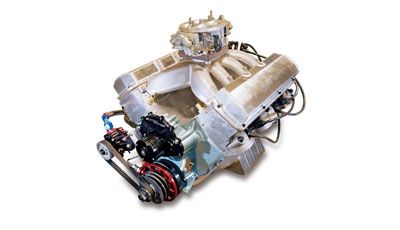
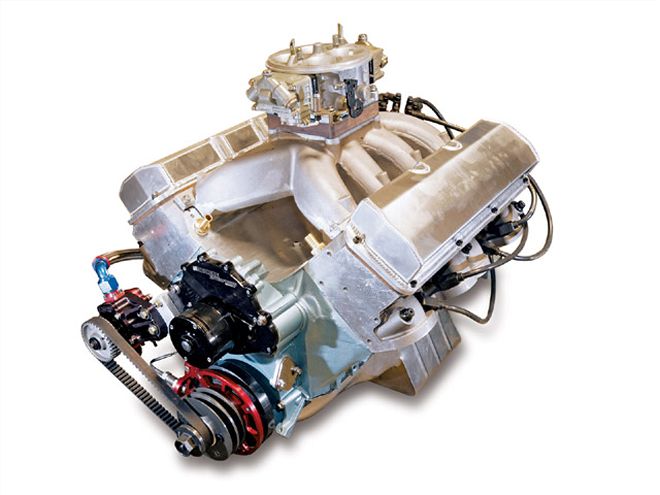 Is it possible to build 750 hp on pump gas using a stock Pontiac block, while staying on a big-block Chevy budget? Recent breakthroughs from Roland Racing, Scat, and SD Performance have come together to make the perfect storm for Pontiac enthusiasts.
Is it possible to build 750 hp on pump gas using a stock Pontiac block, while staying on a big-block Chevy budget? Recent breakthroughs from Roland Racing, Scat, and SD Performance have come together to make the perfect storm for Pontiac enthusiasts.
When Bo Darville, aka the "Bandit," and Cledus Snow, aka the "Snowman," were called upon to deliver a load of bootleg beer from Texarkana to Atlanta, they knew they needed a good rig and a blocker with a fast car to distract the smokeys along the way. Bandit was ready to roll with his buddy, and thanks to a fire-breathing Trans Am with a bird the size of Texas on the hood, they made their gig. It wasn't necessarily Cledus or even the Bandit who were the stars of the movie, it was that car. That car inspired throngs of fans to shove aside any loyalties to lesser brands and spend their lives building Pontiac power. Recently a couple of Pontiac lovers joined forces to see what kind of power they could make with an all new cylinder head and a whole bag of tricks.
Our story began in the not-too-distant past when Jim Sammons of Roland Racing was busy building Pontiac engines. He couldn't find the power that he wanted and he knew that the deficit was in the heads. He recalled: "It started three years ago when I was looking around for some type of head to replace the factory iron round-port heads that were on my '72 Formula. I just didn't see anything out there that really fit the bill that showed a really significant performance improvement. So I took it upon myself to design something with canted valves. Because knowing the limitations of the Pontiac engine, being a typical small-bore-spacing type engine in comparison with other big-blocks, having splayed valves was about a necessity to have good breathing and make the bore look bigger to the valve."
Knowing he would need a design that would incorporate the best features he could squeeze into the platform he was working with, namely Pontiac-size bores and bore spacing, he decided to copy one of the best designs from the NASCAR ranks. A friend had a Yates Ford NASCAR head and Jim borrowed it to study the port dimensions and configuration. Drawing on his experience as an application engineer designing valvetrain setups for a major supplier to the Big Three in Detroit, he was able to convert his ideas into three-dimensional drafts in CAD software.
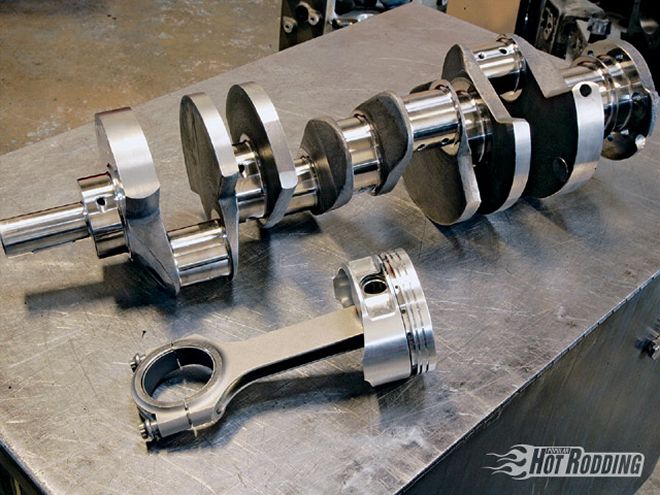 The first key to our Pontiac performance breakthrough is from Scat. These affordable bombproof 4340 forgings have been tested to well over 1,000 hp, but until now, the crank was only available for a big-block Chevy. Part of the crank's strength lies in the thickness of the material leading to the throw (or crank) pin area. Other brands may grind this area down to lighten the crank, but in turn sacrifice strength there, as that is the most common area for a crank to break.
The first key to our Pontiac performance breakthrough is from Scat. These affordable bombproof 4340 forgings have been tested to well over 1,000 hp, but until now, the crank was only available for a big-block Chevy. Part of the crank's strength lies in the thickness of the material leading to the throw (or crank) pin area. Other brands may grind this area down to lighten the crank, but in turn sacrifice strength there, as that is the most common area for a crank to break.
As the timeline progressed, Jim pushed his resources and connections and was rewarded with his first batch of castings in March of 2008. They were called the Roland Racing CV-1 cylinder heads. Initial plans were to use an existing Yates intake manifold with spacers, but as things shaped up, it was clear that he would need to fabricate a dedicated intake. So, in whirlwind fashion, Jim designed and cast his own matching intake design.
Enter the second player in our story. Andy Mitchell of Outlaw Racing Engines in Upland, California, is a hardcore machinist through and through. When Andy heard about the new CV-1 heads, he snapped up a set and pushed to get an engine built that would prove one way or the other the quality and performance of these heads on a street/strip stroker. Andy said: "We wanted to make 750 hp on pump gas without breaking the stock block."
Andy sourced a 400 block as his base, then started flipping through catalogs to find the right pieces to complement the build. A forged Scat 4.5-inch crank and matching 6.7-inch H-beam rods are time-tested ingredients that would withstand the power planned for the mill. To make the block survive, however, took a little ingenuity.
One of the weak points in a Pontiac block is the lifter bore design. With the intake and valley pan removed, one can easily see the bores, which look like they are floating out in space, unsupported. In solid-roller cam applications, it is not totally uncommon for the lifter bores, especially on the passenger side, to break free of the block. That could lead to a very bad day for Andy and Jim. Andy called up SD Performance, and ordered one of their Deluxe Mega Brace kits. The kit consists of several plates that clamp down to support the bores. It's a lifesaver.
Another point our engine-building friend addressed was regarding the main bores. Using the stock, cast-iron, two-bolt mains is fine for mild applications, but when things get wild, it's time to upgrade. Andy installed a set of steel Milodon four-bolt main caps and line-bored the block to ensure perfect alignment of all the mains, and to aid in setting bearing clearance. Once the crank was set in the mains, it drove a Comp Cams custom solid roller cam. It's not too wild, the cam only had 0.455 lift...at the lobes! OK, so Andy may have slid his finger to the proverbial bottom of the page, then flipped it over before finding the lobes he liked. But hey, you gotta respect a guy who isn't afraid of some cam!
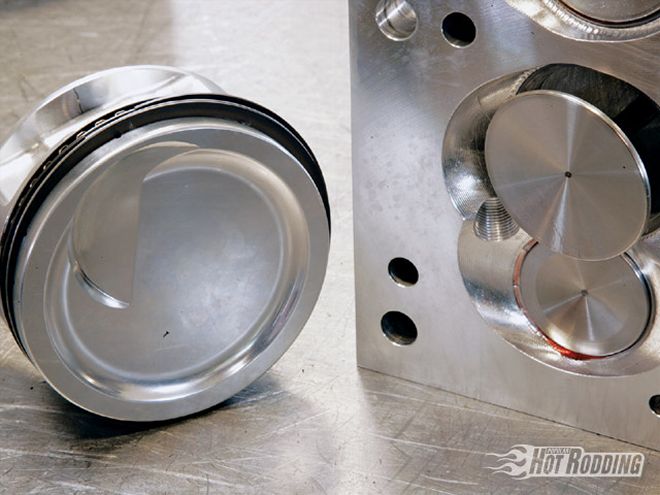 JE built a set of pistons that were a perfect complement to the CNC-machined combustion chambers. Outlaw Racing's Andy Mitchell believes the spherical dish and dual-quench chamber design form an effective team for reducing detonation.
JE built a set of pistons that were a perfect complement to the CNC-machined combustion chambers. Outlaw Racing's Andy Mitchell believes the spherical dish and dual-quench chamber design form an effective team for reducing detonation.
JE Pistons was contacted to provide a set of custom pistons that would work with the heads, providing a streetable 11:1 compression and clearing the mucho grande cam. The ring grooves were cut to allow the use of low-tension Total Seal Gapless piston rings. Cylinder bores in stock-block applications often flex when making big power, so as Andy said, "We filled the block to within an inch of the top with Hardblock."
The essentials of the bottom end were rounded out with a Milodon oil pan equipped with a drain that fed to a Peterson single-stage external oil pump. At first glance, it might appear a little overkill, but for the money, it's a great setup that is easy to assemble, and puts control of the oil pressure and volume within easy reach. To aid in controlling oil, the CV-1 heads are made with an improved oil passage. Jim says: "Because I cast a large 1-inch passage right down the middle of the cylinder head, oil flows much better out of this head. There is a dramatic improvement in oil drain, which is a big problem with racing applications with guys. Guys dragstrip racing these things tell me they have much better oil drain, especially when they cross the finish line and jab the brakes. It is essential to have the oil in the pan and not all in the heads."
The foundation was laid, and it was time for the new heads to take their place. Andy slid on a fresh pair of Felpro head gaskets and a set of Outlaw Racing Engines' custom-length ARP head studs designed specifically for the CV-1 heads. Since the CV-1 heads are a totally new design, they were not hindered by the constraints of the Pontiac catalogs, so they determined that based on valve and pushrod locations, it would be possible and certainly cheaper to use big-block Chevy rocker arms. Andy was familiar with the Australian Yella Terra rocker arms, so he chose those. As designed, they eliminate the use of pushrod guideplates by using individual trunion-mounted rocker arms that locate their mounting angle with the installation of a small roll pin aligning the trunion block with the cylinder head. With the stout cam lobes, a set of heavy-duty pushrods from Comp Cams was chosen to reduce flex and ultimately increase the power and longevity of the engine.
Roland Racing actually offers two different intake manifolds for their heads, a tunnel ram, and the single four-barrel design used on this monster. A quick glance at the intake and it is obvious that Jim, though he claims not to be an expert on runner design, made a beautiful and fully functional piece. The runners are big and sweeping, and take advantage of the factory Pontiac "spider" design with a separate valley pan to keep the heat off the bottom of the intake. Perched in the middle of the spider's web was a Holley 1,050hp Dominator carb. Known as the carb of choice among the big-block crowd, it delivered great performance right out of the box, and with a little tuning, got even better.
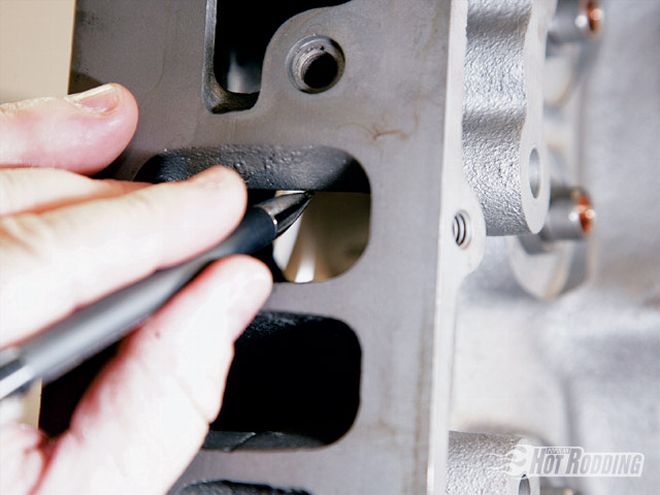 Stock Pontiac heads have tall, narrow runners, as dictated by the pushrod locations. The pushrod pinch in the intake port is the biggest bottleneck for making big horsepower with a Pontiac.
Stock Pontiac heads have tall, narrow runners, as dictated by the pushrod locations. The pushrod pinch in the intake port is the biggest bottleneck for making big horsepower with a Pontiac.
With the heads and intake taken car of, Andy set the valve lash at 0.016 inch, poured in an ample supply of Quaker State Q Racing synthetic oil, and it was ready to fire up. Adjusting ignition timing was a snap with the MSD crank trigger. Andy was surprised at the efficiency of the combustion chambers. "They only wanted 30 degrees of timing, and I was expecting maybe 34 or 36. With that compression, we've even gone up to 40 degrees sometimes." Jim insists that it is not only the combustion chamber's design that resulted in good low ignition timing, but the cooling passages in the heads. As water enters the block through the Mezeire water pump, it passes along all of the cylinders and then rises up through the heads. The cooling passages in the head are set up so that half of the coolant goes to the front of the head, and half to the rear. This necessitates four-corner watering, but customers have reported as much as a 10- or 20-degree drop in operating temps from running the heads. The dyno engine used individual water outlets for ease of installation on the dyno. Jim states: "The water crossover is a piece that you can use off of about any other Pontiac aluminum or iron intake. I didn't cast one into it because it seems like the first thing Pontiac performance guys do when they put on an intake manifold is they cut off the water passage so they can pull the intake manifold without draining the water." He also says that there are aftermarket manufacturers of the crossovers by themselves.
After a lengthy session on the pump at Westech's dyno facility, the 496-inch Poncho turned in an amazing 755 hp and 636 lb-ft of torque. What is even more astounding is how flat the torque curve was, making over 600 pound-feet from the hit at 4,900, all the way until 6,600 rpm. With that kind of torque, the Bandit's old Trans Am could probably pull a trailer load of beer all the way to Atlanta without the big rig! Poor old Sheriff Buford T. Justice would never rest again.
CV-1 Heads And Intake
When Jim Sammons of Roland Racing decided to up the stakes in the game of Pontiac go-fast goodies, he knew that in order for his new cylinder head venture to be successful, it would have to appeal to more than just a few souls. He would need to make his heads affordable and usable by the average racer and hot-rodder.
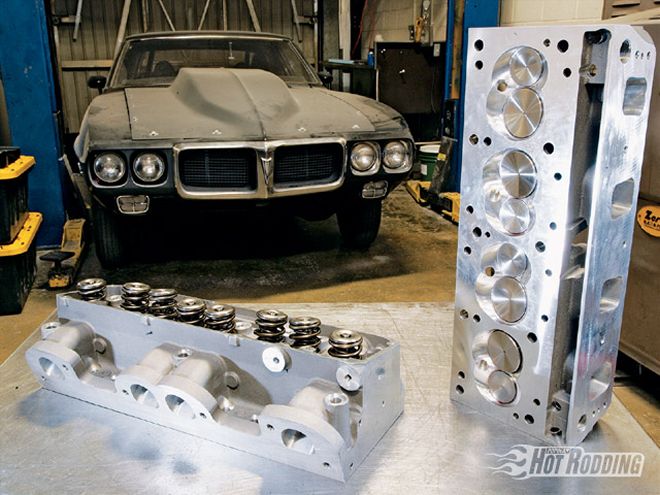
On the first count, with a retail price or $2,995, the heads are not necessarily giveaways, but they are definitely reasonable for someone looking to bolt on over a hundred horsepower. For that price, the heads come assembled with quality stainless steel 2.25-/1.73-inch valves, titanium retainers, and springs adequate for a solid-roller cam up to 0.800 lift. As an option, they have what they refer to as a convertible exhaust port. They will actually mill off the typical Pontiac-style downswept exhaust ports all the way back to the main body of the head, and the customer is left with an exhaust port design and bolt pattern similar to that of a small-block Chevy. Totally new and different, the convertible exhaust option has gained instant fans in the turbo world as it makes building a turbo header much easier.
As for the usability of the head, Jim claims: "The front and back of the heads do retain the full complement of bolt holes for alternator, power steering, and even air conditioning brackets will work too." Additionally, they use stock head gaskets with just minor trimming required in non-critical areas that would give clearance for the relocated pushrods. Every set of heads comes with clear instructions for the trim job. As mentioned in the article, the heads were designed for use with normal big-block Chevy rocker arms, and come with correct guideplates to locate 3/8-inch pushrods.
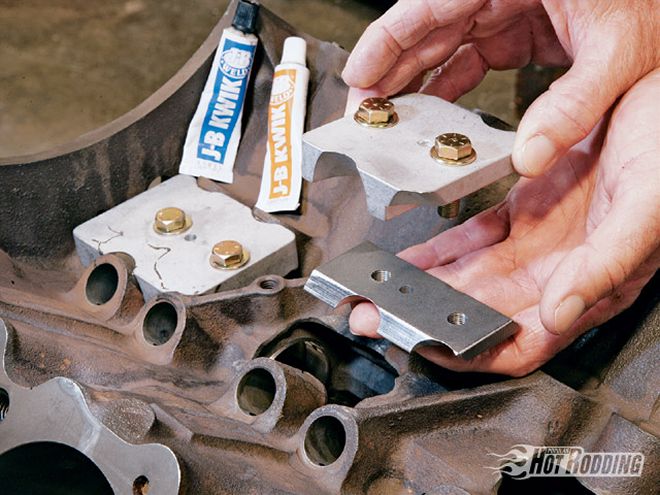
SD Performance Lifter Bore Girdle
There are several specialty manufacturers and suppliers to the Pontiac fold, but SD Performance has risen to the top for several of its components, most famously though for is its patented SD Performance Mega Brace. The brace consists of a set of contoured metal pieces that sandwich the lifter bores into a fixed position so that under the stress of an aggressive cam, the chances of breaking off one of the lifters bores is reduced to almost nil. Andy Mitchell of Outlaw Racing Engines says: "They'll break lifter bores on the passenger side because there is no support. They break the number 1, 2, and 5 lifter bore on the passenger side. When I get to the [Comp Cams] High Torque 440 lobe, then that's when it needs to happen. It has to do with the aggressiveness of the cam from seat to seat." A small application of epoxy helps bond the brace to the block, and seals the oil from pouring down the middle of the cam and crank.